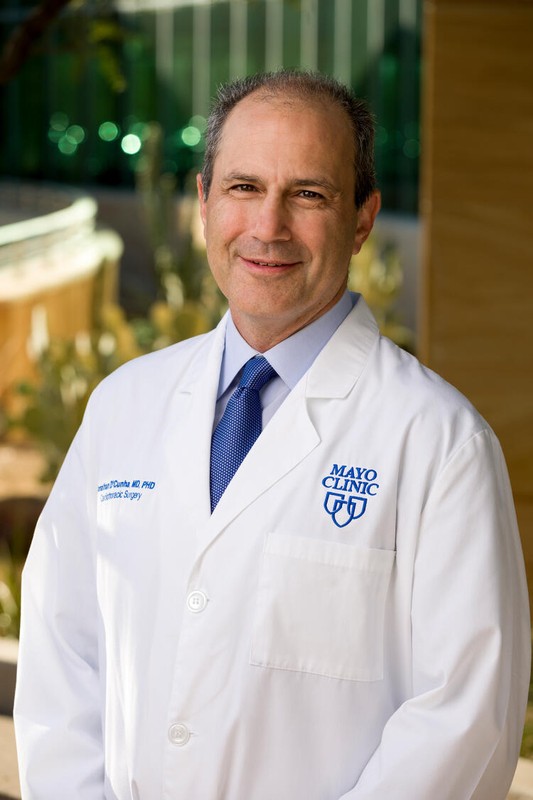Dr. Jonathan D’Cunha is a prominent figure in the field of cardiothoracic surgery, currently serving as the Chair of Cardiothoracic Surgery at Mayo Clinic Arizona and a Professor of Surgery at the Mayo Clinic College of Medicine.
With a rich background that includes a PhD in microbiology/immunology and significant contributions in immunotherapy, the career of Dr. Jonathan D’Cunha has been marked by groundbreaking work in lung transplantation and immunological research. His commitment to education and innovation is evident in his numerous awards and leadership roles across prestigious institutions.
This interview delves into his career journey, professional growth, and insights on leadership and innovation in the medical field.
What does your typical day look like, and how do you make it productive?
My day starts with something I call “The Practice,” which helps me set my mind for the day. I exercise and get ready for a 7 am start, whether it’s a meeting or the operating room. On days I’m not in the operating room, I’m usually busy with meetings, seeing patients in the clinic, and managing hospital patients under my care. As a Department Chairman, there’s often a situation to deal with, and emergencies or transplants can challenge the day. I wrap up between 5 and 7 pm and head home to catch up with my family while tying up any loose ends from work. During the week, I also track moving projects, research, and educational initiatives.
How do you stay informed about industry trends and emerging technologies?
Reading is key. It’s part of my top ten tips. I consistently read the latest literature, as well as books and other materials outside of medicine. Attending meetings helps me stay current and gather ideas. I also talk with leaders around the country and the world to exchange ideas and remain up-to-date. Additionally, I constantly question why we do things a certain way, leading me back to the literature to explore innovative approaches.
Can you recall a significant challenge or failure you faced and how you overcame it?
Since I started my current role, I’ve been challenged with launching a lung transplant program. The pandemic highlighted the perils of lung failure and underscored the need for excellent medical and surgical care for lung failure, including lung transplantation. While there has been tremendous support, the leadership challenges have been remarkable and rewarding. I’ve had to lean on numerous team members and colleagues and develop new skills to reach the point of opening the program.
What is your approach to starting a new project?
When beginning a new project, I like to take the idea and think about it briefly to let it settle and mature. I then conduct background work to identify potential pitfalls. This is followed by discussing it with stakeholders to gain consensus and support for moving forward. I then create a concept sheet or presentation and start the process of socialization to gather additional feedback. The toughest part of getting something off the ground is that projects can be heavy lifts. Working a little bit every day on what seems like a mountain to climb can reduce the weight of the jumpstart and gain significant momentum after a short period.
What was the toughest decision you’ve had to make in the last few months? What was the outcome? Would you do anything differently today?
The toughest decision was recognizing when someone wasn’t bringing their best self to the team and trying to guide them toward self-improvement. When that team member isn’t willing to put in the work and match words with actions, it can leave you as a leader feeling empty and deflated. Sometimes this results in recognizing that the fit isn’t right, and the best decision is to part ways. It can be tremendously challenging for a leader to make these tough decisions and then learn from them.
How has the field of cardiothoracic surgery evolved over the years, and what changes do you foresee in the future?
Cardiothoracic surgery has seen immense advancements, particularly in minimally invasive techniques and improved patient outcomes. The focus on enhanced recovery after surgery has changed preoperative and postoperative care standards. We’ve also witnessed remarkable progress in the area of organ transplantation, with better immunosuppressive therapy regimens that have improved patient and graft survival. Looking ahead, I anticipate that innovations in artificial intelligence and machine learning will further revolutionize the field by improving diagnostics and surgical planning. Moreover, regenerative medicine and bioengineering hold the potential to transform how we treat complex heart and lung diseases .
Could you elaborate on some of the achievements that you are most proud of in your career?
Throughout my career, I’ve had the privilege of contributing to several advancements in lung transplantation and immunotherapy. There have been several “firsts” in my career that I am particularly proud of especially since those techinques/advancements went against the grain. Additionally, spearheading the lung transplant program at Mayo Clinic Arizona has been a testament to my team’s dedication and resilience. These achievements reflect not only my personal efforts, but also the collaborative spirit that drives innovation in healthcare .
What role does innovation play in your work, and how do you cultivate it within your team?
Innovation is the cornerstone of progress in medicine. I encourage my team to think beyond conventional boundaries and explore novel ideas. We foster a culture of continuous improvement by promoting interdisciplinary collaboration and supporting research initiatives. I also emphasize the importance of learning from other industries to apply new methodologies in our field. By maintaining an open environment where every team member feels valued and heard, we create a fertile ground for innovative solutions to emerge.
In terms of leadership, what principles do you adhere to, and how have they influenced your career?
Leadership, in my view, is about empowering others to achieve their best. I adhere to principles like integrity, transparency, and empathy. These have profoundly shaped my career, enabling me to build strong teams and foster a collaborative environment. I believe that a leader should be a coach and a mentor, providing guidance while encouraging autonomy. This approach not only helps in achieving organizational goals but also in nurturing future leaders within the team .
How do you envision the future of healthcare, particularly in the areas of surgery and patient care?
The future of healthcare is poised to become more personalized and patient-centric. Advances in genomics and precision medicine will enable us to tailor treatments to individual patients, improving outcomes and reducing adverse effects. In surgery, robotic-assisted techniques and augmented reality are likely to become more prevalent, enhancing surgical precision and reducing recovery times. Furthermore, with the integration of digital health technologies, patients will have greater access to care and engage more actively in their health management .
What advice would you give to young professionals aspiring to enter the medical field today?
For those entering the medical field, I would advise embracing lifelong learning and being open to new ideas. Medicine is constantly evolving, and staying current with the latest knowledge and technologies is crucial. Building strong mentorship relationships is also essential. A mentor can provide invaluable guidance and support throughout your career. Most importantly, always prioritize patient care and maintain empathy, as these are the core values that drive our profession .
Dr. Jonathan D’Cunha journeys through the complexities of cardiothoracic surgery highlights the importance of innovation and leadership in medicine. His vision for the future remains rooted in improving patient care through cutting-edge technologies and fostering a collaborative, forward-thinking healthcare environment.
By Chris Bates










